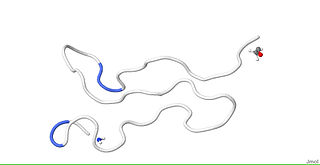
Mothers against decapentaplegic homolog 7 or SMAD7 is a protein that in humans is encoded by the SMAD7 gene.

Bone sialoprotein (BSP) is a component of mineralized tissues such as bone, dentin, cementum and calcified cartilage. BSP is a significant component of the bone extracellular matrix and has been suggested to constitute approximately 8% of all non-collagenous proteins found in bone and cementum. BSP, a SIBLING protein, was originally isolated from bovine cortical bone as a 23-kDa glycopeptide with high sialic acid content.

Transforming growth factor alpha (TGF-α) is a protein that in humans is encoded by the TGFA gene. As a member of the epidermal growth factor (EGF) family, TGF-α is a mitogenic polypeptide. The protein becomes activated when binding to receptors capable of protein kinase activity for cellular signaling.

Cripto is an EGF-CFC or epidermal growth factor-CFC, which is encoded by the Cryptic family 1 gene. Cryptic family protein 1B is a protein that in humans is encoded by the CFC1B gene. Cryptic family protein 1B acts as a receptor for the TGF beta signaling pathway. It has been associated with the translation of an extracellular protein for this pathway. The extracellular protein which Cripto encodes plays a crucial role in the development of left and right division of symmetry.

Receptor activity modifying protein 2, also known as RAMP2, is a protein which in humans is encoded by the RAMP2 gene.

Heparin-binding EGF-like growth factor (HB-EGF) is a member of the EGF family of proteins that in humans is encoded by the HBEGF gene.

Epiregulin (EPR) is a protein that in humans is encoded by the EREG gene.

The gastrin-releasing peptide receptor (GRPR), now properly known as BB2 is a G protein-coupled receptor whose endogenous ligand is gastrin releasing peptide. In humans it is highly expressed in the pancreas and is also expressed in the stomach, adrenal cortex and brain.

Beta-microseminoprotein is a protein that in humans is encoded by the MSMB gene. For historical reasons, the scientific literature may also refer to this protein as Prostate secretory protein 94 (PSP94), microseminoprotein (MSP), microseminoprotein-beta (MSMB), beta-inhibitin, prostatic inhibin peptide (PIP), and inhibitin like material (ILM).

Insulin-like growth factor-binding protein 7 is a protein that in humans is encoded by the IGFBP7 gene. The major function of the protein is the regulation of availability of insulin-like growth factors (IGFs) in tissue as well as in modulating IGF binding to its receptors. IGFBP7 binds to IGF with low affinity compared to IGFBPs 1-6. It also stimulates cell adhesion. The protein is implicated in some cancers.

Thioredoxin-dependent peroxide reductase, mitochondrial is an enzyme that in humans is encoded by the PRDX3 gene. It is a member of the peroxiredoxin family of antioxidant enzymes.

Protein tyrosine phosphatase type IVA 3 is an enzyme that in humans is encoded by the PTP4A3 gene.

The Transmembrane protein with an EGF-like and two follistatin-like domains 2 (TMEFF2) gene is located on chromosome 2q32-q33 and encodes a 374-residue long single polypeptide, type-I transmembrane proteoglycan. According to the HUGO gene nomenclature committee, the aliases of TMEFF2 include, HPP1, Tomoregulin (TR), Transmembrane protein TENB2 (TENB2), Cancer/testis antigen family 120, member 2 (CT120.2) and Transmembrane protein containing EGF and follistatin domains (TPEF). TMEFF2 was identified and characterized by at least five independent groups within the time span of approximately a year.

Wnt inhibitory factor 1 is a protein that in humans is encoded by the WIF1 gene. WIF1 is a lipid-binding protein that binds to Wnt proteins and prevents them from triggering signalling.

ETS domain-containing protein Elk-4 is a protein that in humans is encoded by the ELK4 gene.

Cadherin-17 is a protein that in humans is encoded by the CDH17 gene.

Mammaglobin-B also known as secretoglobin family 2A member 1 is a protein that in humans is encoded by the SCGB2A1 gene.

Protein kinase C-binding protein NELL2 is an enzyme that in humans is encoded by the NELL2 gene.

Rho-related BTB domain-containing protein 1 is a protein that in humans is encoded by the RHOBTB1 gene.

Discoidin, CUB and LCCL domain-containing protein 2 is a protein that in humans is encoded by the DCBLD2 gene.























